
![]() Government figures that link our city to other “similar areas” are flawed, argues Geoff Beacon
Government figures that link our city to other “similar areas” are flawed, argues Geoff Beacon
YorkMix reported that Public Health England put York at the bottom of a league for premature deaths.
The “similar areas” are chosen by what they call the “socioeconomic deprivation bracket”. One of the responses to the article from council leader James Alexander pointed out that York was the only city in the list was the odd one out.
Another of his comments said that the Government says York’s lung disease issues are related to both smoking and air pollution. Using the information that my company Beacon Dodsworth generates together with other surveys, I decided to investigate.
Affluence in York
One of our products, P² People & Places, classifies residential neighbourhoods using data gleaned from sources such as the UK census. At the highest level each postcode is given one of 14 codes ranging from A to M (plus a code for unknowns U).
Neighbourhoods in category A are the most affluent and those in category M are the least affluent. However, affluence is not the only determining characteristic. Aspects like the degree of urbanisation also affect the classification of a neighbourhood. Here are the categories at this highest level, which we call the “tree level”.
You can see the categories for areas of York (or anywhere else in the UK) by visiting the Beacon Dodsworth website and putting in a valid postcode. Here is an example map for the Clifton area:
There are two other levels of the P² classification, the branch level, which has 42 categories and the leaf level which has 151 categories. In calculating the results I give below, I used the 42 categories of the branch level of P².
How does this relate to the premature deaths?
Public Health England chose the group of local authorities according to socioeconomic deprivation.
Their league table is based on the idea that the measure of social deprivation will predict the level of premature deaths. The higher the level of deprivation the greater the expected number of premature deaths.
To a large extent this works but it is a bit too simple so I looked for other measures that might help to give a richer picture. One cost-effective way is to use a geodemographic classification, like our P² People and Places in conjunction with other data.
The warnings on the cigarette packets tells us “Smoking Kills” so a good place to test for health-related similarities or differences is to look at the incidence of smokers in each local authority.
I could estimate the likely level of smoking within local authority areas using P² because it is coded against the Living Cost and Food Survey from the Office Of National Statistics. For each of the 42 P² branch level categories this survey can be used to estimate their expenditure on tobacco.
Knowing the P² makeup of the local authorities enabled me to make predictions of the amount spent on tobacco in each of them. Here are the predictions for the amount spent on tobacco averaged over the population of each local authority:
| Local authority | Spend per head £ per week |
|---|---|
| Bromley | 3.57 |
| North Somerset | 3.67 |
| West Sussex | 3.71 |
| Dorset | 3.74 |
| Cambridgeshire | 3.76 |
| Oxfordshire | 3.76 |
| Cheshire East | 3.83 |
| Wiltshire | 3.85 |
| Essex | 3.94 |
| North Yorkshire | 3.95 |
| Gloucester | 4.02 |
| East Yorkshire | 4.04 |
| Merton | 4.07 |
| Warwickshire | 4.08 |
| York | 4.18 |
These estimated figures give York a 17 per cent higher spend on tobacco than Bromley because York has more people in the groups that are the heaviest smokers. Let us call the categories of households that nationally average more than £6 per week expenditure on tobacco as “the smoking classes”.
Here are the P² categories that make up the smoking classes:
| P2 branch code | P2 branch name | Spend per head £ per week |
|---|---|---|
| L39 | Rootless families | 10.76 |
| L37 | Deprived youth | 10.03 |
| L32 | Assisted families | 8.24 |
| M38 | Hard to let | 7.75 |
| J34 | Young parents | 7.52 |
| M40 | Cramped flats | 7.36 |
| J30 | Council terraces | 7.26 |
| K36 | Sheltered singles | 7.16 |
| J27 | Limited labour | 7.05 |
| J28 | Manufacturing pride | 6.41 |
| G23 | Routine families | 6.21 |
My calculations show that 5.8% of Bromley’s population comes from these smoking classes compared to 16.7% of York’s population. I think this shows that the populations of Bromley and York are not so similar after all.
Public Health England should consider ways other than socioeconomic deprivation bracket of putting Local Authorities into their league tables. Geodemographic classifications, such as Beacon Dodsworth’s P² People and Places, could help.


